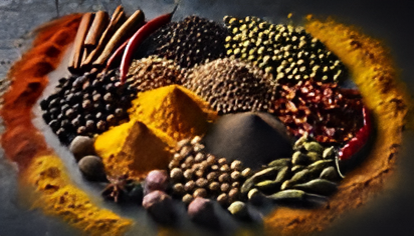The World of Spices: A Culinary Journey

Spices have been an integral part of human history, enriching our cuisines, enhancing our health, and even playing roles in trade and cultural exchanges. This article delves into the fascinating world of spices, exploring their origins, types, health benefits, and culinary uses.
The Origins of Spices
Spices have been used for thousands of years, dating back to ancient civilizations. They were highly prized in trade routes, especially along the Silk Road, connecting the East and West. Spices like black pepper, cinnamon, and cardamom were once more valuable than gold. The spice trade not only influenced culinary practices but also shaped economies and cultures.
Types of Spices
Spices can be categorized into several types based on their origins and uses:
- Seeds and Fruits: These include spices like black pepper, cumin, and coriander. These spices are typically used whole or ground to enhance flavors in various dishes.
- Barks: Cinnamon is the most well-known bark used as a spice. Its sweet and warm flavor makes it a favorite in both sweet and savory dishes.
- Roots and Rhizomes: Ginger and turmeric fall under this category. Both spices not only add unique flavors but also boast numerous health benefits.
- Leaves: Bay leaves and basil are examples of leaf spices. They are often used fresh or dried to infuse dishes with their aromatic qualities.
- Flowers: Saffron, derived from the stigmas of the crocus flower, is one of the most expensive spices in the world, prized for its distinct flavor and vibrant color.
Popular Spices and Their Uses
- Black Pepper: Known as the “king of spices,” black pepper is one of the most widely used spices globally. It enhances the flavor of almost any dish, from soups and stews to meats and vegetables.
- Cinnamon: Often associated with sweet dishes, cinnamon can also be used in savory recipes, particularly in Middle Eastern cuisine. Its warm, sweet flavor pairs well with apples, oats, and even meats.
- Cumin: This spice is a staple in Indian, Mexican, and Middle Eastern cooking. Its earthy, warm flavor is often found in spice blends like garam masala and taco seasoning.
- Turmeric: Known for its vibrant yellow color, turmeric is a key ingredient in curry powder. It has anti-inflammatory properties and is often used in health-conscious dishes.
- Chili Powder: A blend of dried chilies and other spices, chili powder adds heat and depth to dishes. It’s essential in Tex-Mex and Indian cuisines.
- Ginger: Fresh or dried, ginger adds a zesty flavor to both sweet and savory dishes. It’s also renowned for its digestive benefits and is commonly used in teas and desserts.
- Cardamom: This aromatic spice is popular in Indian sweets and chai tea. Its unique flavor also enhances savory dishes, especially in South Asian cuisine.
- Nutmeg: Often used in baking and holiday dishes, nutmeg has a warm, sweet flavor that complements both sweet and savory recipes.
- Cloves: With a strong and pungent flavor, cloves are used in both sweet and savory dishes, as well as in spice blends like garam masala.
- Saffron: As one of the most expensive spices, saffron is prized for its flavor and color, commonly used in dishes like paella and risotto.
Health Benefits of Spices
Many spices are not only flavor enhancers but also offer health benefits:
- Anti-Inflammatory Properties: Spices like turmeric and ginger are known for their anti-inflammatory effects, making them popular in health-conscious diets.
- Antioxidants: Spices such as cinnamon and cloves are rich in antioxidants, which help combat oxidative stress and may reduce the risk of chronic diseases.
- Digestive Health: Ginger and cumin can aid digestion, helping to soothe stomach issues and promote overall gut health.
- Heart Health: Garlic, a common spice, is linked to lower blood pressure and improved cholesterol levels.
- Blood Sugar Regulation: People with diabetes can benefit from cinnamon because it has been demonstrated to help control blood sugar levels.
Culinary Applications of Spices
Knowing how to use spices will improve the quality of your food. Here are some tips for incorporating spices into your dishes:
- Experiment with Blends: Create your own spice blends to enhance the flavor of dishes. For example, mix cumin, coriander, and paprika for a versatile seasoning.
- Toast Spices:Before grinding, toast entire spices to bring out their flavor. Just a few minutes in a dry skillet can bring out their natural oils and aromas.
- Use Fresh Herbs: Combine dried spices with fresh herbs to create depth in flavor. Fresh basil, parsley, and cilantro can complement spices beautifully.
- Marinate with Spices: Use spices in marinades for meats and vegetables. A mixture of yogurt, garlic, cumin, and paprika makes for a flavorful marinade.
- Infuse Oils and Vinegars: Add spices to oils and vinegars for a unique flavor boost. Toasting entire spices before grinding them can improve their flavor.
Conclusion
Spices are more than just flavor enhancers; they are a celebration of culture, history, and health. By exploring the diverse range of spices available, you can transform your cooking and discover new flavors. Whether you’re an experienced chef or a home cook, embracing spices can lead to a more vibrant and flavorful culinary experience.
Incorporating spices into your daily meals not only enhances taste but also provides a multitude of health benefits. So, the next time you reach for that jar of spice, remember the rich history and potential health perks it brings to your table. Happy cooking!